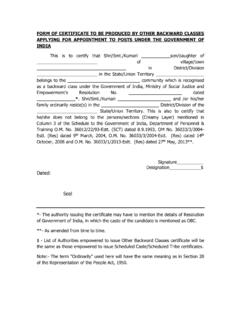Transcription of THE BHAGAVAD GITA
1 THE BHAGAVAD GITA Translated from the Sanskrit with Introduction and Notes by B. Srinivasa Murthy Foreword by Christopher Chapple 2 THE BHAGAVAD GITA Translated from the Sanskrit with introduction and notes by B. Srinivasa Murthy Revised Second Edition Foreword by Christopher Chapple Long Beach Publications 3 Books by the same author: Mahatma Gandhi and Leo Tolstoy Letters, edited with introduction and notes by B. Srinivas Murthy. Long Beach Publications, 1987. Martin Heidegger in Conversation, edited by Richard Wisser, translated by B. Srinivasa Murthy. Arnold Heinemann, New Delhi, India, 1978. Mother Teresa and India, Long Beach Publications, 1983.
2 Library of Congress cataloging-in-Publication Data Bhagavadgita. English. The BHAGAVAD Gita / translated from the Sanskrit with introduction and notes by B. Srinivasa Murthy; foreword by Christoipher Chapple. Rev. 2nd ed. Includes bibliographical references. ISBN 0-941910-05-09 : $ I. Murthy. B. Srinivasa. II. Title. 1991a 924 dc20 90-82501 CIP Copyright 1985 by B. Srinivasa Murthy Second Printing 1995 Revised and enlarged second edition copyright 1991 by B.
3 Srinivasa Murthy. All rights reserved. No part of this book may be reproduced or transmitted in any form or by any means, electronic or mechanical, including photocopying, recording, or any information storage and retrieval system, without permission in writing from the Publisher. Printed in the United States of America. 4 CONTENTS Foreword Preface vii Introduction 1 1. The Grief of Arjuna 29 2. The Path of Reality 35 3. The Yoga of Action 45 4. The Yoga of Knowledge 51 5. The Yoga of Renunciation 57 6.
4 The Yoga of Meditation 63 7. Knowledge and Experience 71 8. The Way to the Eternal Brahman 75 9. The Yoga of Mysticism 81 10. The Divine Manifestations 87 11. The Vision of the Universal Form 93 12. The Yoga of Devotion 101 13. Matter and Spirit 105 14. The Three Gunas 111 15. The Yoga of the Supreme Self 115 16. Divine and Demonic Traits 119 17. Three Kinds of Faith 123 18. Liberation through Renunciation 127 Notes 137 Glossary 145 Bibliography 147 5 With deep appreciation and gratitude to: my parents Mary Jo Murthy Professor von Rintelen Dr.
5 James Harper Dr. Douglas McConnell 6 FOREWORD The BHAGAVAD Gita coalesces drama and philosophy, poetry and religion. As the pivotal moment in a colossal tragedy, it evokes the collective spiritual memory of Indian civilization as embodied by the reflection and insight of Sri Krishna. The time of the Gita is sacred time. The event takes place in a state of suspended animation. The dialogue between Krishna and Arjuna requires the stoppage of all activity, a stoppage that is symbolic of and metaphorical for the cessation of conventional concerns to allow the emergence of highest consciousness.
6 The text places a wedge in reality that interrupts the life flow of the reader. To pause to read of attachment and crisis yielding to detachment and bliss engenders in the reader the same: Gandhi knew this well, and retreated to this great song daily. Dozens of translations of the Gita have been published over the years. Though this is a timeless text in its original Sanskrit, the reading of it into Western languages is framed and construed according to the translator s time and place and audience. Edgerton crafted a linguistic marvel, holding to the original Sanskrit, the reading of it into Western languages is framed and construed according to the translator s time and place and audience.
7 Edgerton crafted a linguistic marvel, holding to the original word order and paving the way for generations of fledgling Sanskritists to be guided through the text into grammatical fluency. Radhakrishnan brought forth a translation that neatly fits certain philosophical expectations and anticipations of those steeped in European intellectual traditions. Christopher Isherwood rendered a fluid, magical combination of poetry and prose, leading his guru Swami Prabhavananda to proclaim that divine inspiration must surely have contributed. Antonio deNicholas used the Gita as a bridge between worlds, providing a basis for the exploration of self and culture regardless of one s native garb.
8 Litt rateurs Ann Stafford and Winthrop Sargeant, to name just two, have reveled in the richness of language and abundance of universal philosophical imagery. 7 The translation of Srinivasa Murthy, like its predecessors, celebrates and pays homage to this great literary and philosophical work. Its use of language is clear and direct, and yet it challenges the reader to enter into the worldview of India. It becomes clear, for instance, that the spirit spoken of in the term purusha is defined not as a personal or substantialist soul but refers to a modality of heightened, spiritualized consciusness, referred to in the Samkhya Karika as the detached witness.
9 Prakriti is not nature in an objective, scientific sense, but provides an accounting for all things that change, including such diverse entities as personality, mood, food, physical realities, and various activities. Likewise, its three components sattva, rajas, and tamas defy facile translation. Srinivasa Murthy leaves these terms in their original, enticing the reader to expand his or her cosmology for the sake of authentically entering into the world of Krishna and Arjuna. Unlike some earlier attempts, this translation is particularly well suited to the uninitiated. It provides a marvelous, concise introduction to the Mahabarata, the great epic of which the Gita is but one small part.
10 It introduces the text with a summary survey of Hindu notions of self and karma, a synopsis of the Samkhya and Yoga schools of thought, and an overview of the paths of action, knowledge, and devotion. Conceived not from the perspective of an outsider looking in nor from the perspective of an insider seeking to mystify the curious, this book admirably makes accessible a great classic of world literature, in a manner true to the Indian tradition. Christopher Chapple December 1990 Loyola Marymount University Los Angeles 8 PREFACE While I was a student of philosophy at the University of Mysore in India, I heard a guest lecturer speak on Sense, Reason and the Self in the Gita, which had a powerful impact upon me.




